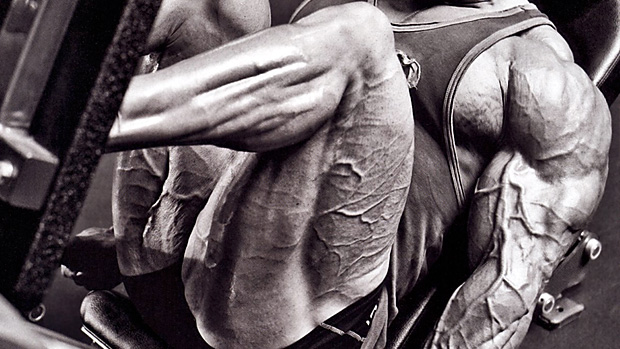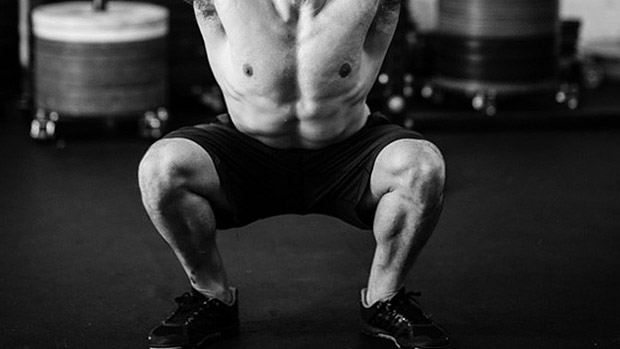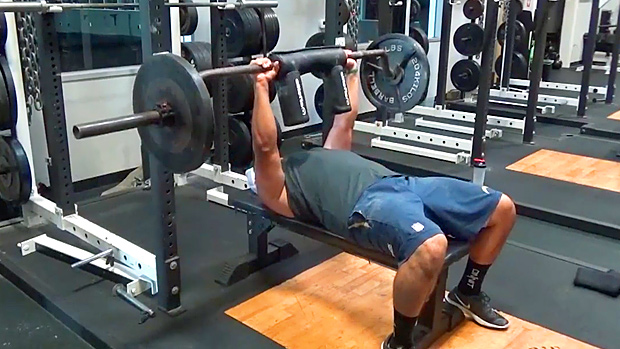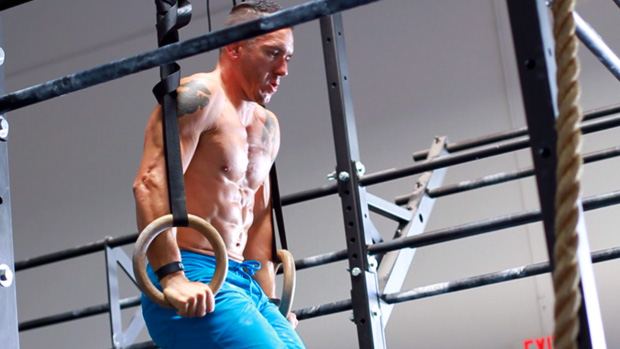"Leg workouts simply have to be brutal to be effective," said Arnold Schwarzenegger. "Normal workouts are hard enough, but if thighs happen to be a weak point in your physique, you have to be prepared to push yourself even more."
"Expect to get quite nauseated," says Charles Poliquin dryly about his own leg specialization programs.
From famous bodybuilders to famous strength coaches, there's one permeating truth when it comes to leg training: it's gonna suck. And perhaps that's why big muscular legs in your gym are as rare as small breasts in Los Angeles.
But if you've got the gonads, we've got the methods to change that. Here are some of the most effective quad-building exercises and routines we've discovered.
1 – The Ultimate Quad Squat

Powerlifters know a whole lot about squatting. And their knowledge has carried over into sports performance training and bodybuilding.
But that's a double-edged sword, because powerlifters are all about maximal efforts, wide stances, a shortened range of motion, and low bar positions. Great for moving a mountain of plates, not so great for targeting quadriceps development.
No, the "quad squat" is a whole different beast compared to the powerlifting squat. We surveyed our stable of coaches and hypertrophy experts and came up with what we call "The Ultimate Quad Squat." Check it out:
- Brace yourself... it's a front squat. Yeah, the bar is uncomfortable. Boo hoo. Get over it! The front squat position allows you to keep the torso as upright as possible, and that's crucial for zeroing in on the quads. It also allows most lifters to more easily squat deeply.
- It's a narrow stance. This shifts tension to the quadriceps and off the glutes and hamstrings. It also increases the range of motion compared to a wide-stance squat.
- There's no complete lock-out. Squat up until you're 2-3 inches away from fully extending the legs. Again, this is all about targeted tension.
- Because of all of the above, yes, you're going to have to use a lighter weight. So set the ego aside and remember this is about hypertrophy, not breaking a 1RM. Many experts believe that the quads require more time under tension (TUT) and higher reps to grow anyway.
- Elevate the heels on a couple of weight plates or a wedged board. This allows greater range of motion and a deeper squat if that's an issue for you, plus it encourages you to push through your toes which gives you more quad activation.
In review: Front squat, narrow stance, no lock-out, lighter weight, heels elevated.
Note: There's a psychological component here as well. This quad squat is perhaps the most ego-crushing lift in existence. Everything about it amounts to the lifter having to lighten the load compared to a powerlifting squat. Some people just can't handle that... and their big asses paired with underdeveloped quads reflect it. Don't be that guy.
2 – The Ultimate Quad Lunge

The lunge is often overlooked by many bodybuilders, and that's too bad. It's great for overall leg and glute development, plus it can be a brutal conditioning exercise. The lunging movement is also classified as a "primal movement pattern" just like the squat. So why neglect it?
To make the lunge into a quad killer, keep these rules in mind:
- Take a short step forward. "The shorter your stride, the more quad-dominant you'll make the movement," notes Mike Robertson.
- Stay upright. Don't lean too far forward. "One of the best cues you can use here is to make yourself 'tall,'" says Robertson. "This simultaneously improves your posture and activates the core musculature."
- When pushing off the forward leg, use your mid-foot as the propulsion point. You can even push off the toes to really emphasize the quads, but this may not be good for knee health. But as long as you stay off the heal when pushing off, you'll stimulate the quadriceps just fine.
Variation: Once you can use a significant amount of weight on dumbbell lunges, progress to barbell lunges. This will allow you to use more weight, plus it raises your center of gravity, requiring better balance and body control.
3 – The Two-Minute Leg Press

Sports performance coaches often poo-poo the leg press because it doesn't transfer well to sport, plus squats are more effective anyway at building overall strength, something that's obviously important to coaches who work mainly with performance athletes. But what about the leg press for bodybuilding?
"The leg press is a great exercise for hypertrophy," says Poliquin, "especially for the quadriceps." So what's the best way to use the leg press for quad size? We'll tell ya: medium to narrow foot position, placed low on the foot plate, and performed with high reps.
High reps? What about "Go heavy or go home!" There's a time and a place for that, but if your quads are only a little bigger than your calves, then it may be time to strip off some plates and go for some nauseating TUT.
Most lifters have a high percentage of slow-twitch fibers in their quadriceps. "With quads, you can go as high as 50 reps per set. There's been some pro-bodybuilders who've grown on 30 reps per set," notes Poliquin.
While not everyone's fiber-make-up is the same – and while varied rep ranges are usually best – we'd say that if you lack quad size, then high reps may be the cure you've been looking for. Here's a routine from Poliquin that puts all this info to work.
Using a much lighter weight than normal, a full range of motion, and the narrow and low foot positions, do leg presses for two straight minutes, no rest. Remember, full-range means you go down until your quadriceps cover your chest.
For each rep, extend your legs to 95% of lockout. Again, the key is to keep the tension on the muscle at all times.
"By the time you finish this exercise, you may want to cough up a lung or two," notes Poliquin. We believe that's his idea of encouragement.
4 – Deadman Quad Raises

"This drill is the equivalent of the natural glute-ham raise for the quadriceps," says Thibaudeau. "While it seems deceptively easy at first glance, it can really burn those quads of yours when performed properly, leaving you limping for quite some time!"
After a ringing endorsement like that, we bet you're just dying to try it, right? (Ya sick bastard.) Here's how to do it:
Start on your knees, with the trunk upright and in line with the upper legs. During the whole movement the trunk and upper thighs must be kept on the same line; this is the key to the effectiveness of this drill.
Lower yourself backward under control – bringing your back toward your feet – while remembering to keep your trunk tight and in line with the upper legs during the whole movement. Lower yourself as low as you can, then come back up to the starting position by tensing your quads hard.
At first you won't need to add any weight to make this exercise hard. As you progress, you can hold a weight plate on your chest to increase the difficulty.
5 – Quadriceps Finishers
A finisher is any movement you add to the end of your regular training session to "finish off" the muscles and further stimulate hypertrophy. It's totally old-school and masochistic... and brutally effective for quad growth.
Just perform your regular heavy compound movements first, then finish off with one of these torture methods:
1 – Iso One-leg Squat

"This exercise is a lesson in pain tolerance," says Christian Thibaudeau. "It can leave the bravest gym rat begging for mercy!"
With your front leg forward, place your back leg on a bench. Bend your front leg so that the upper leg is parallel to the floor with the knee in line with the front foot. The trunk should be kept upright with hands on your hips.
Hold that position for 60 seconds per leg. If you can handle that length of time, you can hold dumbbells in your hands or a plate across your chest.
2 – Ski Squat

We learned this from strength coach Ian King. The ski squat sneaks up on you like a ninja. You'll think it's easy at first, but you'll think again by the end of it!
Place your feet shoulder-width apart, about two feet out from the wall, and lean your back against the wall. Bend your knees to a partial-squat position. This is position one.
After 10 seconds, lower down to position two, about two inches lower. After 10 more seconds, lower another two inches down to position three. You should be about thigh parallel by now. Use another two lower positions, with position five being about as far as you can bend at the knees.
Most people are quivering lumps of Jell-O by this point. If you're not: Extend each static position to 20 seconds, do it one leg at a time, or come back up after you work your way down the wall.
Can you smell that? That's lactic acid seeping from your pores.
3 – Single-Leg Partial Squats

Another killer body weight finisher from Ian King:
Stand on the edge of a low block (1/3 to 1/2 the height of normal bench height). Have the weak leg on the box and the strong leg off the edge of the box. With your hands on your hips, bend at the knee of the weak side, lowering down (two to three seconds) until the sole of your foot almost brushes the floor.
Keep the sole parallel to the ground. Pause for one second and return to full extension in about one to two seconds. At the tenth rep, pause at the bottom position for ten seconds. You must not rest the non-supporting leg on the ground at any stage during the set! Then continue reps until you get to 20. Repeat the ten-second pause.
"Can you go on? If yes, remember that you have to finish what you start!" notes King. "This exercise must be done in multiples of ten, with a ten-second pause in the bottom position at the completion of every ten reps. If you get to 50 reps, look to raise the height of the block."
If possible, don't hold onto anything during the set – the challenge of having to balance yourself will add to the fatigue. However, you may wish to do this near a wall or squat stand, just in case. And be careful when you get off the block at the end of the set!
Wrap-Up
Arnold also said that leg training "...involves a mental effort almost as much as a physical one. This means forcing yourself to break down any inhibition or barrier."
Knowing the exercises and routines is one thing. Putting them to work, with intense mental focus and eyeball-popping effort, is quite another. Are you ready?
Model: Beau Myrick
Location: Gym, Abilene, Texas





